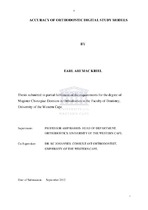| dc.contributor.advisor | Harris, Angela Manbre Poulter | |
| dc.contributor.advisor | Johannes, K.C. | |
| dc.contributor.author | Kriel, Earl Ari Mac | |
| dc.date.accessioned | 2015-09-07T23:16:56Z | |
| dc.date.available | 2015-09-07T23:16:56Z | |
| dc.date.issued | 2012 | |
| dc.identifier.uri | http://hdl.handle.net/11394/4513 | |
| dc.description | Magister Scientiae Dentium - MSc(Dent) | en_US |
| dc.description.abstract | Background: Plaster study models are routinely used in an Orthodontic practice. With the recent introduction of digital models, an alternative is now available, whereby three dimensional images of models can be analyzed on a computer. Aims and objectives: The aim of this study was to compare the measurements taken on digital models created from scanning the impression, digital models created from scanning the plaster model, and measurements done on the plaster models. The objectives were: Measurement differences between those taken directly on plaster models compared with
measurements on digital models created from scanned impressions and digital models created from scanned plaster models. Methods: The study sample was selected from the patient records of one Orthodontist. They consisted of 26 pre-treatment records of patients that were coming for orthodontic treatment. Alginate impressions were taken of the maxillary and the mandibular arches. Each impression was scanned using a 3Shape R700™ scanner. Ortho Analyzer software from 3Shape was used to take the measurements on the digital study models. Within 24 hours plaster study models were cast from the impressions, and were scanned using a 3Shape R700™ scanner. On the plaster models the measurements were done with a MAX-CAL electronic digital calliper. The mesiodistal width as well as intermolar and intercanine width for both the maxillary and mandibular models were recorded.Results and discussion: Box plots used to compare the variability in each of the three measurement methods, suggest that measurements are less variable for Plaster. Plaster measurements for tooth widths were significantly higher (mean 7.79) compared to a mean of 7.74 for Digital Plaster and 7.69 for Digital impression. A mixed model analysis showed no significant difference among methods for arch width. Conclusions: Digital models offer a highly accurate alternative to the plaster models with a high degree of accuracy. The differences between the measurements recorded from the plaster and digital models are likely to be clinically acceptable. | en_US |
| dc.language.iso | en | en_US |
| dc.publisher | University of the Western Cape | en_US |
| dc.subject | Orthodontics | en_US |
| dc.subject | Study models | en_US |
| dc.subject | Digital technology | en_US |
| dc.title | Accuracy of orthodontic digital study models | en_US |
| dc.type | Thesis | en_US |
| dc.rights.holder | University of the Western Cape | en_US |

